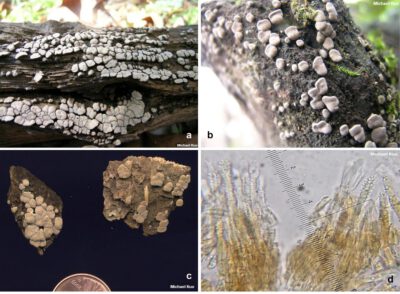Fungalpedia – Note 203, Xylobolus
Xylobolus P. Karst.
Citation if using this entry: Bera et al. 2024 (in prep) – Fungalpedia, Basidiomycota 1.
Index Fungorum, MycoBank, Facesoffungi, GenBank, Fig. 1
Classification: Stereaceae, Russulales, Agaricomycetes, Basidiomycota, Fungi.
Xylobolus, circumscribed by Karsten (1881), is often related to another genus Stereum Hill ex Pers., yet is distinguished by the presence of ellipsoid basidiospores, an abundance of achantocystidia, and the absence of any cystidia resembling smooth conducting hyphae which is a characteristic feature in all Stereum taxa (Ryvarden 2012). Members of Xylobolus are known to cause “pocket rot” on decaying wood which is unlikely in Stereum (Ryvarden 2012). The basidiomata of this genus have a perennial habit and vary from being resupinate to pileate having quite a tough texture (Ryvarden 2012). The upper surface of the basidiomata can be glabrous to hirsute or tomentose with deep brown to black colour tones, while the hymenium appears pale brownish to beige with a smooth to undulant surface (Ryvarden 2012). The hyphal system is dimitic, with septate generative hyphae and thick-walled skeletal hyphae, along with numerous achantocystidia and skeletocystidia (Ryvarden 2012). The 4-sterigmatic basidia are usually clavate, occasionally small protrusions at the apex, which is characterized for acanthobasidia (Ryvarden 2012). The basidiospores, responsible for the white pocket rot, have a positive amyloid reaction with Melzer’s reagent (Ryvarden 2012).
Most of the taxa of Xylobolus share similar micro-morphological characteristics, except X. gongylodes Popoff & J.E. Wright, which have unique, longer basidiospores (Ryvarden 2012). The classification of Xylobolus is based on the basidiomata’s color and other morphological features, which are primarily superficial (Ryvarden 2012). Lim & Jung (2000) inferred the phylogenetic relationship of Xylobolus and allied genera based on the nrITS region and revealed the polyphyletic nature of the genus. The polyphyletic taxa within Xylobolus have been transferred to different genera, such as Acanthophysium (Pilát) G. Cunn., Amylostereum Boidin, Acanthofungus Sheng H. Wu, Boidin & C.Y. Chien, etc. The type species, Xylobolus frustulatus (Pers.) P. Karst., is a thoroughly documented crust fungus renowned for its distinctive appearance when fully developed (O’Kennon et al. 2018). It is commonly referred to as the ceramic or parchment fungus (Persoon 1801, Boidin 1958, Kuo 2008, O’Kennon et al. 2018). With its maturity, the crust fractures into uneven, ivory-colored plates called “frustules,” with each plate separated by a dark sepia “grout.” Xylobolus frustulatus primarily thrives on mature, deceased, and decaying oak trees (O’Kennon et al. 2018). Currently, 11 species have been documented worldwide under Xylobolus (Species Fungorum 2023). The lack of taxonomic knowledge of Xylobolus calls for a more extensive and focused study combining morphology and phylogeny.
Type species: Xylobolus frustulatus (Pers.) P. Karst. (≡ Thelephora frustulata Pers.:Fr.)
Other accepted species: (Species Fungorum – search Xylobolus)
- Xylobolus austrosinensis S.H. He,
- Xylobolus brasiliensis Chikowski,
- Xylobolus gongylodes Popoff & J.E. Wright,
- Xylobolus hiugensis (Imazeki) Imazeki & Hongo,
- Xylobolus illudens (Berk.) Boidin,
- Xylobolus peculiare (Parmasto, Boidin & Dhingra) Ryvarden,
- Xylobolus princeps (Jungh.) Boidin,
- Xylobolus spectabilis (Klotzsch) Boidin,
- Xylobolus subpileatus (Berk. & M.A. Curtis) Boidin,
- Xylobolus thoenii (Boidin, Lanq. & Gilles) Ţura, Zmitr., Wasser & Spirin
Figure 1 – Xylobolus frustulatus. a-c. Basidiomata. d. Section through hymenium. Taken from Kuo (2008).
References
Kuo M. 2008 – Xylobolus frustulatus. Retrieved from the MushroomExpert.Com Website.
Persoon CH. 1801 – Synopsis Methodica Fungorum (in Latin). Gottingen, Germany. 577 p.
Ryvarden L. 2012 – A note on the genus Xylobolus P. Karst. Synopsis Fungorum, 30, 17–24.
Entry by
Ishika Bera, Center of Excellence in Fungal Research, Mae Fah Luang University, Chiang Rai 57100, Thailand
(Edited by Kevin D Hyde, Samaneh Chaharmiri-Dolhaharani, & Achala R. Rathnayaka)
Published online 15 February 2024
